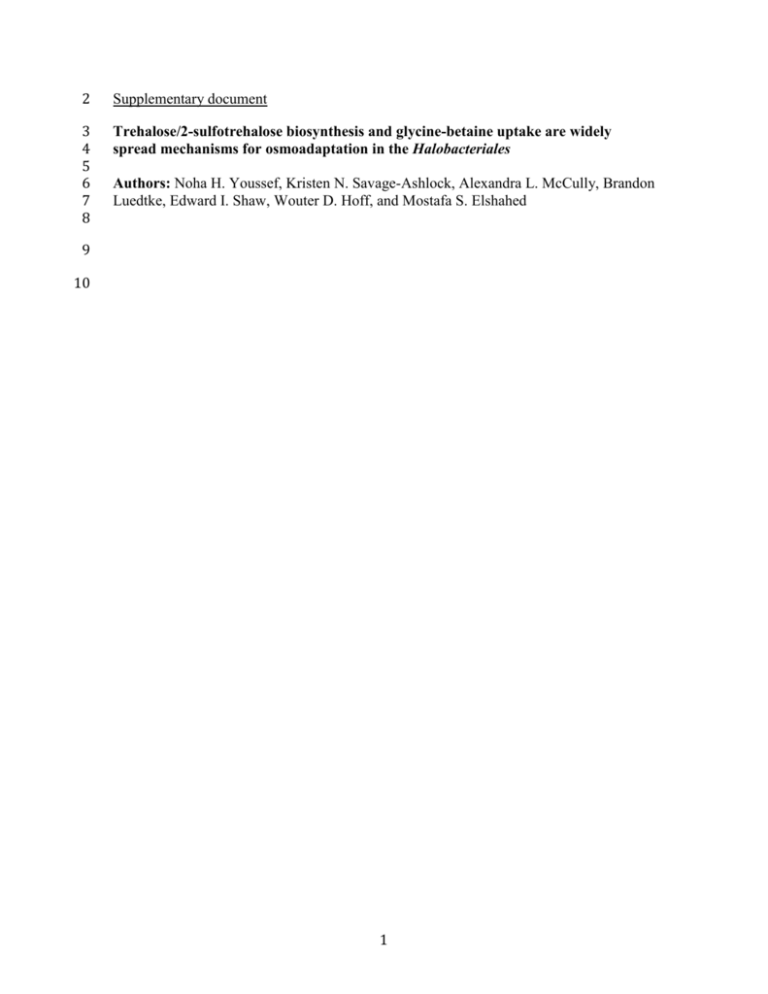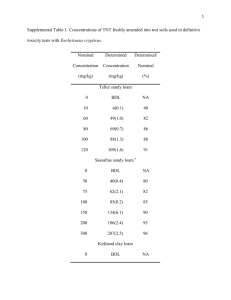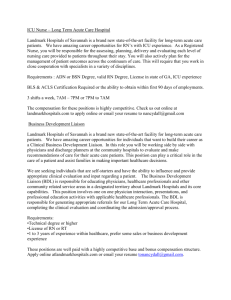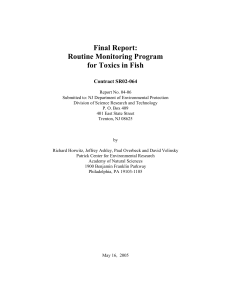Supplementary document Trehalose/2
advertisement

2 Supplementary document 3 4 5 6 7 8 Trehalose/2-sulfotrehalose biosynthesis and glycine-betaine uptake are widely spread mechanisms for osmoadaptation in the Halobacteriales Authors: Noha H. Youssef, Kristen N. Savage-Ashlock, Alexandra L. McCully, Brandon Luedtke, Edward I. Shaw, Wouter D. Hoff, and Mostafa S. Elshahed 9 10 1 11 12 Detailed Materials and Methods 13 Archaeal strains. Haladaptatus paucihalophilus strain DX253T (DSM18195) was 14 isolated from Zodletone spring, a sulfide- and sulfur-rich spring in southwestern 15 Oklahoma (Savage et al 2007), and maintained in our laboratory. Natrialba magadii 16 DSM3394, Natrinema pellirubrum DSM15624, Natronobacterium gregorii DSM3393, 17 Natronococcus occultus DSM3396, Halalkalicoccus jeotgali DSM18796, and 18 Haloterrigena turkmenica DSM5511 were kindly provided by Drs. Jonathan A. Eisen 19 and Marc T. Facciotti (University of California Davis). All other strains were purchased 20 from the German Collection of Microorganisms (DSMZ, Braunschweig, Germany). All 21 cultures were maintained in DSMZ-recommended media (Table S1) on sealed agar plates 22 or agar slants and stored at 4ºC. 23 Genome of Haladaptatus paucihalophilus strain DX253T. DNA was extracted from 24 100 mls of a late exponential phase culture using MoBio Powersoil DNA Extraction kit 25 (MO BIO Laboratories, Carlsbad, California). The high-quality extracted DNA was 26 sequenced using the service of a commercial sequencing provider (Engencore, now Selah 27 Genomics, Columbia, South Carolina) using 454 FLX technology. The genome was 28 assembled using Newbler assembler into 32 Contigs (N50 = 267, 250 bp, N90 = 100,497 29 bp). Gene calling, annotation, and metabolic construction was conducted using the 30 Department of Energy Integrated Microbial Genomes (IMG) platform (Markowitz et al 31 2012). 32 Growth media and Experimental setup. Haladaptatus paucihalophilus was grown in a 33 defined media containing (g.l-1): MgCl2.6H2O (20), K2SO4 (5), CaCl2.2H2O (0.1), NH4Cl 34 (0.5), KH2PO4 (0.05), and sodium pyruvate (0.5). The medium was buffered to a pH of 2 35 6.8 using 25mM HEPES. After autoclaving, 1 ml of modified Wolin’s metal solution 36 containing (g.l-1): EDTA, 0.5; MnSO4·H2O, 3; NaCl, 1; CaCl2·2H2O, 0.1; ZnSO4·7H2O, 37 0.1; FeSO4·7H2O, 0.1; CuSO4·5H2O, 0.01; AlK(SO4)2, 0.01; Na2MoO4·2H2O, 0.01; boric 38 acid, 0.01; Na2SeO4, 0.005;NiCl2·6H2O, 0.003, and 10 ml of vitamin solution (Widdel 39 and Pfennig 1981) were added to 1 l of the above medium. This medium has a similar 40 composition to DSMZ 1125, but with no yeast extract and with pyruvate rather than 41 sucrose as a carbon source. This was done to ensure that any compatible solutes detected 42 in cell extracts are synthesized de novo. NaCl concentrations were varied between 75-275 43 g.l-1 in different experiments. All other strains were cultured in their DSMZ media at 44 three different salt concentrations (Table S1) that are close to their lower, optimum, and 45 higher NaCl growth range. In experiments assessing glycine betaine uptake in 46 Haladaptatus paucihalophilus, glycine betaine (10 g.l-1, Sigma-Aldrich, St. Louis, MO) 47 was added to the growth medium described above. For all other microorganisms, no 48 glycine betaine was added since they were grown in complex media containing yeast 49 extract, where glycine betaine is one of its components (estimated at 110 μg/g yeast 50 extract (Dulaney et al 1968)). Approximately, 1.5x108 cells in the exponential phase were 51 used as an inoculum for 250 ml cultures in all experiments. Cultures were grown to late 52 exponential phase (O.D. ~0.5), harvested, and used for the quantification of various 53 intracellular solutes as described below. 54 Analytical methods. 55 Identification of compatible solutes in cell-free ethanol extracts. The presence and 56 identity of compatible solutes in cell-free extracts were initially screened using 1H- 57 nuclear magnetic resonance spectroscopy (1H-NMR), and high performance liquid 3 58 chromatography (HPLC). Cell pellets were extracted using a modified ethanol extraction 59 method (Falicia Goh et al 2011). Cell pellets were washed three times in a sterile isotonic 60 NaCl solution, followed by lyophilization. The lyophilized cell pellets were extracted 61 with 70% ethanol, vortexed for 5 min, then centrifuged at 10,000 xg for 10 min. Ethanol 62 extraction was repeated 2 more times and the combined ethanol extracts were evaporated 63 overnight at 37ºC. For HPLC analysis, dried ethanol extracts were re-dissolved in water 64 and 20 µl were analyzed on an Agilent 1100 Series (Santa Clara, CA) HPLC with a 65 refractive index detector and an Aminex HPX-87P column. Analysis was conducted at 66 85°C using a mobile phase of deionized water pumped at 0.6 mL/min for 30 min (Sluiter 67 et al 2008). Trehalose was identified in the cell-free extracts by comparison to a trehalose 68 standard (Sigma-Aldrich). For 1H-NMR analysis, dried ethanol extracts were dissolved in 69 0.5 ml of D2O and 0.09 mM solution of 2,2-Dimethyl-2-Silapentane-5-Sulfonate-d6 70 sodium salt (DSS) in D2O. Spectra were taken at 25oC with a one-pulse sequence with 71 water pre-saturation on a Varian Inova 600 NMR spectrometer with a 5 mm indirect 72 detection probe, using a 1.5 second pre-saturation delay between pulses and 6.6 73 microsecond 90 degree pulse. The spectra were referenced to DSS at 0 ppm, with error in 74 ppm values of +/- 0.05 ppm. Spectra were transformed with MNova software (Masterlab 75 research, Santiago de Compostela, Spain), using solvent signal suppression to remove the 76 residual water resonance. Reference trehalose was used for comparison. 77 Quantification of ions and compatible solutes. Cell pellets were washed in sterile 78 isotonic NaCl solution. After removal of all traces of medium, the pellet was frozen at - 79 20ºC overnight followed by thawing in 10 ml solution of 10% perchloric acid (PCA). 80 Thawed pellets were vortexed for 5 min, followed by incubation at room temperature for 4 81 2 hours during which cells lysed and proteins precipitated. Extracts were then centrifuged 82 at 10,000 xg for 15 min. The pellet containing the precipitated proteins was suspended in 83 0.85% saline solution and used for protein quantification using total protein kit (Micro 84 Lowry kit, Onishi and Barr Modification by Sigma Aldrich). The supernatant, containing 85 the cell-free, protein-free, extract was used for quantification of intracellular solutes and 86 ions as described below. 87 Quantification of trehalose in cell-free extracts. The concentration of trehalose in cell- 88 free PCA extracts was determined enzymatically (Neves et al 1994) using a trehalase 89 assay kit (Megazyme®, Wicklow, Ireland). In addition to trehalose, this enzymatic assay 90 is suitable for the quantification of 2-sulfotrehalose, a putative compatible solute 91 previously identified in a few alkaliphilic Halobacteriales genera (Natrialba magadii, 92 Natronobacterium gregorii, and Natronococcus occultus (Desmarais et al 1997)). This is 93 due to the fact that trehalase enzyme requires only one free hydroxyl group at the 2′ 94 position for hydrolytic activity (Mori et al 2009, Ocon et al 2007), and hence the presence 95 of a sulfonate group at one of the 2′ positions should not hinder its activity. 96 Therefore, to differentiate trehalose from 2-sulfotrehalose, we devised a fast 97 method to detect the presence of a 2′-O-sulfonate group based on the action of abalone 98 snail sulfatase (Sigma-Aldrich), shown to be specific for cleaving the 2′-O-sulfonate 99 group of trehalose (Uzawa et al 2004), followed by quantification of the released 100 inorganic sulfate turbidimetrically (Lundquist et al 1980). PCA extracts positive for 101 trehalose were assayed for the presence of free inorganic sulfate before and after 102 treatment with abalone snail sulfatase (1 U per 1.5 µmole trehalose for 75 hours at 37ºC). 103 Differences in inorganic sulfate content were converted to µmole sulfate and compared to 5 104 the total amount of trehalose (µmoles) in the extracts. The sulfate:trehalose ratio obtained 105 for Natronococcus occultus, previously shown to produce 2-sulfotrehalose (Desmarais et 106 al 1997), was 0.44±0.26. This value is in accordance with the previously reported yield of 107 abalone snail sulfatase of 28% on p-nitrophenyl-2-O-sulfo-glycoside (Uzawa et al 2004). 108 Sulfate:trehalose ratios > 0.1 were deemed indicative of 2-sulfotrehalose production. By 109 comparison, the sulfate:trehelose ratio for Haladaptatus paucihalophilus, shown by 1H- 110 NMR to produce trehalose rather than 2-sulfotrehalose, never exceeded 0.01. 111 Quantification of glycine betaine in cell-free extracts. Glycine betaine was quantified in 112 PCA extracts using a colorimetric assay for quaternary ammonium compounds (QACs) 113 as described before (Grieve and Grattan 1983). The assay is based on the precipitation of 114 QACs as their periodide salts. Under acidic conditions (pH 0-1) and at low temperatures 115 (0-4ºC), betaine precipitates, when reacted with a KI-I2 reagent, as glycine betaine- 116 periodide complex, which has a characteristic absorbance at 365 nm when dissolved in 117 1,2-dichloroethane. Concentrations of glycine betaine in PCA extracts were calculated 118 using a glycine betaine standard curve (0-200 µg/ml). 119 Quantification of intracellular potassium in cell-free extracts. Intracellular K+ levels 120 were quantified in cell free extracts of various Halobacteriales species 121 spectophotmetrically using an approach based on the formation of K+-K+-specific 122 ionophore complex in the presence of a dye anion followed by the extraction of the K+- 123 K+-specific ionophore complex using an organic solvent and measuring the increase in 124 the absorbance of the organic layer (Takagi et al 1981). PCA extracts were mixed with 125 the K+-specific ionophore, Kryptofix 221 (Sigma Aldrich) in the presence of the anionic 126 dye picrate. The K+-Kryptofix 221 complex was then extracted by vortexing with 6 127 toluene. The increase in the absorbance of the organic layer, proportional to the K+ 128 concentration in the PCA extracts, was measured at 360 nm against toluene. 129 Quantification of intracellular free amino acids in cell-free extracts. PCA extracts were 130 assayed for free amino acids using the services of the Protein Chemistry Lab of Texas 131 A&M University. Free Amino acids are derivatized with o-phthalaldehyde (OPA) and 9- 132 fluoromethyl-chloroformate (FMOC). OPA reacts with all amino acids except proline, 133 while FMOC reacts with proline. The derivatized amino acids are separated by reverse 134 phase HPLC on an Agilent 1260 liquid chromatograph using a 5 µm reverse phase 135 column and a gradient elution using 100% solvent A (20mM Na acetate buffer with 136 0.018% v/v triethylamine, 0.05mM EDTA, and 0.3% tetrahydrofuran, pH 7.2) at 0 min, 137 going to 60% Solvent B (100 mM Na acetate buffer: acetonitrile: methanol (1:2:2 v/v)) 138 over 17 min with flow rate of 0.45 ml/min. Amino acids tagged with OPA are detected at 139 338/390 nm by the Variable Wavelength (UV) detector (G1365D), while proline (tagged 140 with FMOC) is detected at 266/324 nm. 141 RNA extraction and gene expression. Total RNA was extracted from triplicate 142 Haladaptatus paucihalophilus cultures grown in defined medium described above in 143 presence of multiple salt concentrations (75, 125, 175, 225, and 275 g.l-1) using Tri 144 Reagent (Ambion®, Austin, TX) (Morgan et al 2010). Cell pellets from late exponential 145 phase cultures were solubilized in TRI Reagent® Solution (Ambion®), and processed 146 according to the manufacturer’s instruction. Contaminating DNA was removed from all 147 RNA preparations using RQ1 DNase (Promega®), followed by phenol/chloroform 148 extraction, and ethanol precipitation. To check for the complete removal of DNA, the 149 RNA preparation was used as a template in a PCR reaction conducted in a 50-μl volume 7 150 mixture containing the following (final concentrations are given): 2 μl of extracted RNA, 151 1× PCR buffer (Promega), 2.5 mM MgSO4, 0.2 mM dNTPs mixture, 2.5 U of GoTaq 152 Flexi DNA polymerase (Promega), and 0.5 µM each of H. paucihalophilus-specific 16S 153 rRNA gene primers F: 5′-GCTTTTGAGAGGAGGTGCAT-3′, and R: 5′- 154 TAATGTACCCAGCCACCACA-3′, corresponding to bases 974-993, and 1078-1097, 155 respectively of H. paucihalophilus 16S rRNA gene (GenBank accession number 156 NR_043744). PCR amplification was carried out according to the following protocol: 157 initial denaturation for 5 min at 95°C, followed by 30 cycles of denaturation at 95°C for 158 45 s, annealing at 55°C for 45 s, and elongation at 72°C for 30 sec. A final elongation 159 step at 72°C for 5 min was included. If needed, the DNase treatment was repeated until 160 the RNA was free of any contaminating DNA as confirmed by PCR. DNA-free RNA was 161 then precipitated using Lithium Chloride Precipitation Solution (Ambion, Carlsbad, CA) 162 according to manufacturer’s instructions to remove any contaminating small RNAs. 163 High-quality RNA preparations were stored at -80ºC until used. Total RNA reverse 164 transcription (cDNA construction) was conducted on 1 µg of RNA preparations using 165 Superscript III first strand synthesis kit (Invitrogen) with random hexamers (Invitrogen). 166 To study the expression levels of genes involved in trehalose synthesis in 167 Haladaptatus paucihalophilus, Reverse Transcription qPCR (RT-qPCR) was conducted 168 on the cDNA obtained using primers shown in Table S2. Levels of expression of 169 different genes were compared to Glyceraldehyde-3-Phosphate dehydrogenase gene 170 expression. qPCR was conducted using a MyIQ thermocycler (Bio-Rad Laboratories, 171 Hercules, CA) and Sybr GreenER qPCR mix (Invitrogen). The 20-µl reaction contained 2 172 µl of cDNA, 0.5 µM each of the forward and reverse primers, and 10 µl of the qPCR mix. 8 173 The reactions were heated at 50°C for 2 min, followed by heating at 95ºC for 8.5 min. 174 This was followed by 65 cycles, with one cycle consisting of 15 sec at 95°C, 60 sec at 175 52°C, and 30 sec at 72°C. 176 Phylogenetic analysis. RpoB′ protein sequences from publicly available Halobacteriales 177 genomes (n=82) were aligned in ClustalX (Larkin et al 2007 ) and used to construct a 178 maximum likelihood tree in Mega (Tamura et al 2011) using a WAG model with Γ 179 distribution of rates among sites as previously suggested (Minegishi et al 2010). Support 180 values were obtained using 1000 bootstrapping events. To examine the evolutionary 181 history of trehalose synthesis, Halobacteriales OtsA (trehalose-6-phosphate synthase), 182 and OtsB (trehalose-6-phosphatase) protein sequences, as well as those from reference 183 bacterial and archaeal taxa were aligned using ClustalX (Larkin et al 2007 ). The 184 alignment was used to predict the best protein substitution model in Mega (Tamura et al 185 2011) using maximum likelihood. The predicted model was applied in maximum 186 likelihood tree construction and support values were obtained using 1000 bootstrapping 187 events. 188 Ecological distribution of otsAB-harboring genera. We examined the correlation 189 between the presence/absence of trehalose synthesis otsAB genes in a genome and the 190 respective salt minimum, maximum and optimum concentrations. We used χ2 191 Contingency tables for correlation (Plackett 1983), since the dependent variable is 192 nominal (dichotomous). The independent variable was converted to nominal values as 193 follows. Values of salt minimum, maximum and optimum concentrations were ranked 194 and grouped into 6 categories: (very low (ranks 1-14), low (ranks 15-27), moderate 195 (ranks 28-40), moderate-high (ranks 41-53), high (ranks 54-66), and very high (ranks 67- 9 196 81)). With the two variables (dependent and independent) being nominal, χ2 Contingency 197 correlation was calculated, and the χ2 values obtained were compared to the tabulated χ2 198 value at α = 0.05. The probability of the result being due to chance (i.e. p-value) was 199 evaluated using the Chi-square calculator http://www.fourmilab.ch/rpkp/experiments 200 /analysis/chiCalc.html. Only in cases where the correlation was significant (p<0.05), the 201 obtained χ2 value was used to calculate Cramer's V statistics; , where χ2 is the calculated χ2 value, n is the number of 202 203 Halobacteriales species with sequenced genomes (n=81), M is the number of rows (or 204 dependent variables, dichotomous), and N is the number of columns (or independent 205 variables), to measure the degree of association between the two variables. 206 To study the correlation between otsAB presence and the ecological distribution 207 of various genera, we reexamined the relative abundance of various Halobacteriales 208 genera in 13 different environments with salinities ranging from permanently hypersaline 209 (n=9), saline and fluctuating salinity habitats (where salinity is usually lower than 250 g.l- 210 1 211 diverse prokaryotic community) (n=3), and mostly non-saline with only occasional 212 development of temporal and spatial pockets (n=1, Zodletone spring). Relative 213 abundances of Halobacteriales genera with and without the OtsAB system in their 214 genome were compared between various groups of environments using Student t test. 215 Values were considered significantly different if the P-value associated with the t test 216 was <0.0038 (equivalent to an α value of 0.05 corrected for 13 pairwise comparisons 217 using the Bonferroni correction). The relative abundances values obtained were also used 218 in a principal-component analysis to evaluate the differences in genera composition , exhibits fluctuation, and the Halobacteriales community is usually a fraction of a more 10 219 between the environments using the R statistical package (R Development Core Team 220 2011). 221 11 222 223 Results: Genes for Na+ extrusion, K+ uptake, and chloride homeostasis in 224 Haladaptatus paucihalophilus genome. 225 At least two Na+ extrusion mechanisms employing the proton electrochemical 226 gradient as the driving force for exporting Na+ exist in the genome: A Na+:H+ antiporter 227 of the NhaC family, and a multisubunit Na+:H+ antiporter similar to MnhABCDEFG. As 228 for potassium uptake, 2 clusters similar to the ATP-dependent low affinity K+ transporter 229 (Trk) exist in the genome, each consisting of the membrane component TrkH and the 230 NAD-binding component TrkA. A voltage-gated K+ channel of the Kef-type, most 231 probably functioning as a facilitated diffusion K+ uniporter driven by the membrane 232 potential, was also identified in the genome. Two voltage-gated Cl- channels of the EriC- 233 type exist in tandem in the genome upstream of a universal stress family protein. It is not 234 clear whether these would be employed in Cl- uptake or extrusion. However, two Na+- 235 dependent transporters of the neurotransmitter:Na+ symporter, NSS family, exist in the 236 genome in tandem. Some of these are known to co-transport Cl-, and could potentially act 237 as an energy-dependent inward chloride pump. 238 239 240 241 242 243 244 245 12 246 247 248 Cui H-L, Gao X, Sun F-F, Dong Y, Xu X-W, Zhou Y-G et al (2010). Halogranum 249 rubrum gen. nov., sp. nov., a halophilic archaeon isolated from a marine solar saltern. Int 250 J Syst Evol Microbiol 60: 1366-1371. References 251 252 Desmarais D, Jablonski PE, Fedarko NS, Roberts MF (1997). 2-Sulfotrehalose, a novel 253 osmolyte in haloalkaliphilic archaea. J Bacteriol 179: 3146-3153. 254 255 Dulaney EL, Dulaney DD, Rickes EL (1968). Factors in yeast extract which relieve 256 growth inhibition of bacteria in defined medium of high osmolarity. Dev Ind Microbiol 9: 257 260-269. 258 259 Falicia Goh, Young Jae Jeon, Kevin Barrow, Brett A. Neilan, Burns BP (2011). 260 Osmoadaptive strategies of the archaeon Halococcus hamelinensis Isolated from a 261 hypersaline stromatolite environment. Astrobiology 11: 529-536. 262 263 Grieve CM, Grattan SR (1983). Rapid assay for determination of water soluble 264 quaternary ammonium compounds. Plant Soil 70: 303-307. 265 266 Larkin MA, Blackshields G, Brown NP, Chenna R, McGettigan PA, McWilliam H et al 267 (2007 ). Clustal W and Clustal X version 2.0. Bioinformatics 23 2947–2948. 268 13 269 Lundquist P, Mårtensson J, Sörbo B, Ohman S (1980). Turbidimetry of inorganic sulfate, 270 ester sulfate, and total sulfur in urine. Clin Chem 26: 1178-1181. 271 272 Markowitz VM, Chen I-MA, Palaniappan K, Chu K, Szeto E, Grechkin Y et al (2012). 273 IMG: the integrated microbial genomes database and comparative analysis system. 274 Nucleic Acid Res 40: D115-D122. 275 276 Minegishi H, Kamekura M, Itoh T, Echigo A, Usami R, Hashimoto T (2010). Further 277 refinement of the phylogeny of the Halobacteriaceae based on the full-length RNA 278 polymerase subunit B' (rpoB') gene. Int J Syst Evol Microbiol 60: 2398-2408. 279 280 Morgan JK, Luedtke BE, Thompson HA, Shaw EI (2010). Coxiella burnetii type IVB 281 secretion system region I genes are expressed early during the infection of host cells. 282 FEMS Microbiol Lett 311: 61-69. 283 284 Mori H, Lee J-H, Okuyama M, Nishimoto M, Ohguchi M, Kim D et al (2009). Catalytic 285 reaction mechanism based on alpha-secondary deuterium isotope effects in hydrolysis of 286 trehalose by European Honeybee trehalase. Biosci Biotechnol Biochem 73: 2466-2473. 287 288 Neves MJ, Terenzi HF, Leone FA, Jorge JA (1994). Quantification of trehalose in 289 biological samples with a conidial trehalase from the thermophilic fungus Humicola 290 grisea var. thermoidea. World Journal of Microbiology & Biotechnology 10: 17-19. 291 14 292 Ocon, Aurora, Hampp, Rudiger, Requena, Natalia (2007). Trehalose turnover during 293 abiotic stress in arbuscular mycorrhizal fungi. New Phytol 174: 879-891. 294 295 Plackett RL (1983). Karl Pearson and the Chi-Squared Test. Int Statist Rev 51: 59-72. 296 297 R Development Core Team (2011). R: A Language and Environment for Statistical 298 Computing. Reference Index., 2.13.2 edn. R Foundation for Statistical Computing: 299 Vienna, Austria. 300 301 Savage KN, Krumholz LR, Oren A, Elshahed MS (2007). Haladaptatus paucihalophilus 302 gen. nov., sp. nov., a halophilic archaeon isolated from a low-salt, sulfide-rich spring. Int 303 J Syst Evol Microbiol 57: 19-24. 304 305 Sluiter A, Hames B, Ruiz R, Scarlata C, Sluiter J, Templeton D et al (2008). 306 Determination of structural carbohydrates and lignin in biomass. National Renewable 307 Energy Laboratory (NREL): Golden, CO. 308 309 Takagi M, Nakamura H, Sanui Y, Ueno K (1981). Spectrophotometric determination of 310 sodium by ion-pair extraction with crown ether complexes and monoanionic dyes. Analyt 311 Chim Acta 126: 185-190. 312 15 313 Tamura K, Peterson D, Peterson N, Stecher G, Nei M, Kumar S (2011). MEGA5: 314 Molecular Evolutionary Genetics Analysis Using Maximum Likelihood, Evolutionary 315 Distance, and Maximum Parsimony Methods. Mol Biol Evol 28: 2731-2739. 316 317 Uzawa H, Nishida Y, Sasaki K, Nagatsuka T, Hiramatsu H, Kobayashi K (2004). 318 Sulfatase-catalyzed assembly of regioselectively O-sulfonated p-nitrophenyl α-d-gluco- 319 and α-d-mannopyranosides. Carbohyd Res 339: 1597-1602. 320 321 Widdel F, Pfennig N (1981). Studies on dissimilatory sulfate-reducing bacteria that 322 decompose fatty acids. Arch Microbiol 129: 395-400. 16 323 324 325 326 Table S1. Microorganisms used in this study and their growth media showing the carbon source, salt concentration used in culturing experiments, carbon sources in growth media, and yeast extract content in these media. Strain Growth medium Culture Salt concentration g.l-1 Carbon source(s) Yeast extract collection (g.l-1) Low Opt High Haloferax mediterranei DSM 372 125 175 225 YE, CAA, Na citrate, Na glutamate 5 Halovivax ruber DSM 514 125 175 225 YE, Peptone 1 Halogeometricum borinquense DSM 372 125 225 275 YE, CAA, Na citrate, Na glutamate 5 Halostagnicola larsenii DSM 1138 175 225 275 YE 5 Halococcus saccharolyticus DSM 372 125 225 275 YE, CAA, Na citrate, Na glutamate 5 Halorhabdus utahensis DSM 927 125 225 275 YE, glucose 1 Halorubrum lacusprofundi DSM 372 125 175 275 YE, CAA, Na citrate, Na glutamate 5 Halosarcina pallida JCM 645 75 175 225 YE, CAA 0.1 Natrialba magadii DSM 371 125 175 275 YE, CAA, Na glutamate 5 Natrinema pellirubrum DSM 372 125 175 275 YE, CAA, Na citrate, Na glutamate 5 Natronobacterium gregoryi DSM 371 125 175 275 YE, CAA, Na glutamate 5 Natronococcus occultus DSM 371 125 175 275 YE, CAA, Na glutamate 5 Halalkalicoccus jeotgali DSM 954 125 175 275 YE, CAA 5 Halogranum rubrum MR2A 125 225 275 YE, CAA, Na citrate, Na glutamate, 0.5 Na pyruvate, glucose, peptone Haloterrigena turkmenica DSM 372 125 175 275 YE, CAA, Na citrate, Na glutamate 5 Natronorubrum tibetense DSM 371 125 175 275 YE, CAA, Na glutamate 5 Halobacterium salinarum DSM 372 175 225 275 YE, CAA, Na citrate, Na glutamate 5 Haladaptatus paucihalophilus DSM 1125 75 125, 175 225, 275 Na pyruvate 0 Eschericia coli K12 10 YE, tryptone 5 YE: yeast extract; CAA: casamino acid M2RA: modified R2A medium as described in (Cui et al 2010), LB contains (g.l-1): yeast extract, 5; tryptone, 10; NaCl, 10. 17 327 Table S2. Primers used for RT-PCR. Gene Accession number qPCR primers otsA1 EFW91797 F: 5’-GTGGGACGTGTTTCGAAGTT-3’ R: 5’-TAGCGAATCACTCCCGTTTC-3’ otsA2 EFW92049 F: 5’-AACTCACGGACGAGCAAGTT-3’ R: 5’-CCCGAGATGGTAATCCTGAA-3’ otsB EFW92050 F: 5’-CAAGAACGAGTCGATGTGGA-3’ R: 5’-GAATCGAGAGTTGCGGAGAG-3’ treT EFW90639 F: 5’-ACCGTCTGGATGGTGAACTC-3’ R: 5’-GTGCAGGAGGTTGTGAATCC-3’ GAPDH EFW92006 F: 5’-TAACGGGTACGGGACTATCG-3’ R: 5’-ATAGCGGCGTAGAGTGGGTA-3’ 328 329 330 331 332 333 334 335 336 337 338 339 340 341 342 343 344 345 346 347 348 349 350 351 352 353 354 355 18 356 357 Table S3. General genomic features as well as protein properties of Haladaptatus paucihalophilus genome. DNA, total number of bases 4,284,805 DNA coding number of bases 3,650,099 (85.2%) DNA G+C number of bases 2,648,659 (61.8%) DNA scaffolds 32 Genes total number 4,496 Protein coding genes 4,443 with function prediction 2,528 Average pI of all protein-coding genes 5.12 Percentage of acidic (D+E) residues 15.95 Percentage of basic (K+R) residues 8.79 Percentage of large hydrophobic residues (I+L+M+F) 18.98 RNA genes 53 rRNA genes 6 5S rRNA 2 16S rRNA 3 23S rRNA 1 tRNA genes 47 358 359 360 361 362 363 364 365 366 367 368 369 370 371 372 373 374 375 19 376Table S4. Comparison of average pI values of cytoplasmic versus membrane proteins in 377different halophilic archaeal and bacterial strains. Microroganism Average pI of proteins Cytoplasmic Membrane Haladaptatus paucihalophilus 4.69 6.88 Haloarcula marismortui 4.1 6.89 Halobacterium salinarum 4.29 7.22 Halorubrum locusprofundii 4.23 6.56 Haloterigena turkmenica 4.42 5.53 Halopiger xanaduensis 4.44 5.36 Halostagnicola larsenii 4.44 5.44 Halovivax ruber 4.42 5.57 Halogeometricum borinquense 4.55 6.06 Halalkalicoccus jeotgali 4.57 6.19 Halomicrobium mukohataei 4.42 5.84 Haloferax sulfurifontis 4.49 6.11 Halorhabdus utahenesis 4.34 5.75 Haloquadratum walsbyi 4.56 6.04 Natrinema pellirubrum 4.51 5.63 Natronobacterium gregoryi 4.49 5.44 Natronococcus occultus 4.4 5.61 Natrialba magadii 4.44 5.38 Natronomonas pharonis 4.38 6.45 Salinibacter ruber 4.36 7.92 Halorhodospira halophila 5.12 8.56 20 378 Table S5. Intracellular levels of trehalose/2-sulfotrehalose, glycine betaine, and potassium in the strains tested. Species Salt conc Osmolytes measuresa (g.l-1) Tre (µmol.mg STre (µmol SO4: GB (µmol.mg K+ (µmol.mg protein-1) µmol Tre) protein-1) protein-1) Haloferax mediterranei 175 BDL NA 8.02 16.26 Halovivax ruber 125 2.56 0 BDL 9.62 175 2.83 0 BDL 8.37 225 2.42 0 BDL 9.48 Halogeometricum borinquense 125 BDL NA BDL 7.67 225 BDL NA 0.98 9.38 Halostagnicola larsenii 175 BDL NA BDL 4.19 225 BDL NA BDL 24.44 275 BDL NA BDL 29.7 Halococcus saccharolyticus 175 3.14 0 1.69 6.24 225 3.17 0 1.81 7.8 275 1.84 0 2.82 5.61 Halorhabdus utahensis 225 BDL NA 0 9.07 275 BDL NA 1.23 11.5 Halorubrum lacusprofundi 125 BDL NA 0 6.5 175 BDL NA 1.45 8.9 275 BDL NA 2.74 22.9 Halosarcina pallida 75 3.07 0 0 3.92 225 3.02 0 1.73 5.6 Natrialba magadii 125 3.38 0.13 BDL 4.33 175 2.11 0.16 BDL 6.61 275 1.67 0.18 BDL 5.53 Natrinema pellirubrum 125 1.62 0.28 BDL 2.42 21 379 380 381 175 1.17 0.17 BDL 2.11 275 1.25 0.26 0.54 2.76 Natronobacterium gregoryi 125 5.88 0.28 BDL 4.36 175 2.43 0.27 BDL 6.62 275 1.66 0.13 BDL 5.12 Natronococcus occultus 125 3.31 0.74 0 4.69 175 1.70 0.31 2.85 3.75 275 1.22 0.27 3.63 3.83 Halalkalicoccus jeotgali 125 3.11 0.28 BDL 4.82 175 2.41 0.18 BDL 4.11 275 2.13 0.32 BDL 4.75 Halogranum rubrum 125 5.80 0 0.56 8.56 225 3.00 0 1.22 5.32 275 2.30 0 1.64 6.75 Haloterrigena turkmenica 125 2.32 0 0.23 3.17 175 2.19 0 1.47 4.67 275 1.28 0 2.05 3.86 Halobacterium salinarum 125 BDL NA 1.58 6.1 175 BDL NA ND 8.88 225 BDL NA 2.43 11.05 275 BDL NA 2.65 12.5 Natronorubrum tibetense 125 3.62 0 BDL 5.24 175 2.09 0 0.82 4.54 275 1.49 0 0.9 4.37 A: osmolytes for which intracellular concentrations were measured in cell-free PCA extracts; trehalose (Tre), glycine betaine (GB), and potassium are all shown in µmoles.mg protein-1. For 2-sulfotrehalose (STre), values shown are µmoles SO42-: µmoles trehalose. BDL: below detection limit, NA: not applicable, BDL: Below detection limit, ND: not determined 22 382 383 23











